A Novel Approach for Modeling and Evaluating Road Operational Resilience Based on Pressure-State-Response Theory and Dynamic Bayesian Networks
Abstract
:1. Introduction
2. Road Operational Resilience
2.1. Definition of Road Operational Resilience
2.2. Analysis of Road Operational Resilience Elements
- The exposure to pressure characterizes the possibility of the road system being exposed to risk scenarios. The higher the exposure, the greater the possibility of disturbance. Specific elements include the exposure to meteorology (E1-1), the exposure to road type (E1-2), and the exposure to traffic flow (E1-3);
- The uncertainty of pressure characterizes the randomness of the time, type, and degree of emergency events on roads. The higher the uncertainty of pressure disturbance, the lower the pressure resilience performance, and the higher the difficulty for road systems to defend against disasters. Specific elements include the diversity of accident types (E2-1) and the diversity of vehicle types (E2-2);
- The diversity of pressures characterizes the possibility that road systems face various types of risks. Under the influence of other external factors, such as complex road environments and vehicle conditions, various disturbances may occur in a coupled and spread manner, increasing the risk of impact. Specific elements include uncertainty of scattered objects (E3-1) and uncertainty of fire (E3-2);
- The risk impact on road emergency occurrences is characterized by the pressure hazard, which includes losses of facilities, personnel, and vehicles. Specific elements include the hazards to the vehicle involved (E4-1), the hazards to casualties (E4-2), and the hazards to the facility (E4-3);
- The state of robustness is the ability of a road system’s inherent properties to resist disturbances, such as physical properties and network topology properties. Specific elements include the robustness of road width (E5-1), the robustness of road maintenance (E5-2), the robustness of pavement performance (E5-3), the robustness of lane access (E5-4), and the robustness of facility functions (E5-5);
- The state redundancy maintains functions through its replaceable components in response to damaged traffic functions. It is generally characterized by the storage capacity and substitutability of resources required by road systems, such as the redundancy of design traffic capacity (E6-1) and the redundancy of road network connectivity (E6-2).
- Response awareness characterizes the timeliness and accuracy of perception for emergency events and risk environments. It is a prerequisite for response occurrence and can be characterized by the rapidity of response arrival (E7-1);
- Rapidity of response refers to the ability of transportation system managers to take emergency disposal measures to restore system functions quickly. It usually manifests itself as effectiveness and speediness in emergency disposal. Specific elements include the implementability of response disposal (E8-1) and the rapidity of response disposal (E8-2);
- The resourcefulness of the response is measured by managers’ ability to organize transportation systems to establish priorities and mobilize various disaster prevention and mitigation resources. It is the basis for response disposal. Specific elements include the availability of rescue resources (E9-1), the availability of traction resources (E9-2), and the availability of firefighting resources (E9-3);
- The term responsive learnability refers to a transportation system’s ability to absorb historical experience and continuously learn so that functional status can be restored as soon as possible or even reach higher performance levels. It is characterized by emergency review capabilities (E10-1).
3. Road Operational Resilience Evolution Based on DBN
3.1. Description of Road Emergency Event Data
- The pressure dimension data includes accident occurrence time, weather conditions, traffic flow during the incident, accident location, accident type, vehicle types, scattered objects situation, fire situation, facility losses, number of involved vehicles, and casualty numbers;
- The state dimension data includes road width, road maintenance situation, pavement performance, total lanes, occupied lanes, facility functions, road network connectivity, and design traffic capacity;
- The response dimension data encompasses accident discovery time, response arrival time, disposal time, response-related resources such as rescue, traction, firefighting resources, and accident logging time.
3.2. Construction of the DBN Structure for Resilience Evolution
3.3. DBN Parameter Learning Based on Node Resilience Status
- Expert selects the most important node and the least important node from a group of nodes ;
- The most important node is compared with other nodes to determine their relative importance using a 1–9 scale, where higher values indicate greater importance, and to calculate the ratio set as Equation (1)where represents the ratio of the importance of the most important node chosen by to other nodes ;
- The importance of other nodes is compared with the least important node using the same scale. The ratio set is calculated by Equation (2).where represents the ratio of the importance of other nodes to the least important node selected by ;
- To obtain the optimal weight , and values should be minimized, and constraints should be set as Equation (3).where represents the weight of the th node given by expert ;
- Convert ratios into node weights, and finally aggregate expert opinions to obtain weights as in Equation (4), where is the weight of expert .
- Determine the identification framework and construct a non-empty set of resilience element states. In this paper, the states of road operational resilience elements are conducive to resilience () and detrimental to resilience evaluation (). All sets of identification framework are called the power set , and their subsets are called focal elements.
- Assign confidence between 0 and 1 to focal elements within the identification framework, determining the Basic Probability Assignment or mass function as Equation (6).
- The Dempster–Shafer combination rule is used to combine two independent mass functions. This method gives us the fusion result of the parent node’s resilience status and the upper-level node’s resilience status. The calculations are as in Equations (7)–(9).
4. Multidimensional Integration and Visualization of Road Operational Resilience Evaluation
5. Case Study
5.1. Construction of the DBN Structure
5.2. DBN Parameter Learning
5.3. Resilience Evolution Analysis
6. Discussion
7. Conclusions
Author Contributions
Funding
Institutional Review Board Statement
Informed Consent Statement
Data Availability Statement
Conflicts of Interest
References
- Ganin, A.A.; Kitsak, M.; Marchese, D.; Keisler, J.M.; Seager, T.; Linkov, I. Resilience and Efficiency in Transportation Networks. Sci. Adv. 2017, 3, e1701079. [Google Scholar] [CrossRef] [PubMed] [Green Version]
- Climate Change Cost New York $8 Billion During Hurricane Sandy—Bloomberg. Available online: https://www.bloomberg.com/news/articles/2021-05-18/climate-change-cost-new-york-8-billion-during-hurricane-sandy#xj4y7vzkg (accessed on 8 April 2023).
- National Data. Available online: https://data.stats.gov.cn/easyquery.htm?cn=C01 (accessed on 14 June 2023).
- Rezvani, S.M.; Falcão, M.J.; Komljenovic, D.; de Almeida, N.M. A Systematic Literature Review on Urban Resilience Enabled with Asset and Disaster Risk Management Approaches and GIS-Based Decision Support Tools. Appl. Sci. 2023, 13, 2223. [Google Scholar] [CrossRef]
- Murray-Tuite, P. A Comparison of Transportation Network Resilience under Simulated System Optimum and User Equilibrium Conditions. In Proceedings of the 2006 Winter Simulation Conference, Monterey, CA, USA, 3–6 December 2006; IEEE: Monterey, CA, USA; pp. 1398–1405. [Google Scholar]
- Lounis, Z. Risk-Based Decision Making for Sustainable and Resilient Infrastructure. J. Struct. Eng. 2013, 142, 1845–1856. [Google Scholar] [CrossRef]
- Zimmerman, R.; Zhu, Q.; de Leon, F.; Guo, Z. Conceptual Modeling Framework to Integrate Resilient and Interdependent Infrastructure in Extreme Weather. J. Infrastruct. Syst. 2017, 23, 04017034. [Google Scholar] [CrossRef]
- Henry, D.; Emmanuel Ramirez-Marquez, J. Generic Metrics and Quantitative Approaches for System Resilience as a Function of Time. Reliab. Eng. Syst. Saf. 2012, 99, 114–122. [Google Scholar] [CrossRef]
- Kammouh, O.; Dervishaj, G.; Cimellaro, G.P. A New Resilience Rating System for Countries and States. Procedia Eng. 2017, 198, 985–998. [Google Scholar] [CrossRef] [Green Version]
- Kammouh, O.; Zamani Noori, A.; Cimellaro, G.P.; Mahin, S.A. Resilience Assessment of Urban Communities. ASCE-ASME J. Risk Uncertain. Eng. Syst. Part A Civ. Eng. 2019, 5, 04019002. [Google Scholar] [CrossRef] [Green Version]
- De Iuliis, M.; Kammouh, O.; Cimellaro, G.P.; Tesfamariam, S. Downtime Estimation of Building Structures Using Fuzzy Logic. Int. J. Disaster Risk Reduct. 2019, 34, 196–208. [Google Scholar] [CrossRef]
- Kammouh, O.; Cimellaro, G.P.; Mahin, S.A. Downtime Estimation and Analysis of Lifelines after an Earthquake. Eng. Struct. 2018, 173, 393–403. [Google Scholar] [CrossRef]
- Kammouh, O.; Noori, A.Z.; Taurino, V.; Mahin, S.A.; Cimellaro, G.P. Deterministic and Fuzzy-Based Methods to Evaluate Community Resilience. Earthq. Eng. Eng. Vib. 2018, 17, 261–275. [Google Scholar] [CrossRef]
- Dehghani, F.; Mohammadi, M.; Karimi, M. Age-Dependent Resilience Assessment and Quantification of Distribution Systems under Extreme Weather Events. Int. J. Electr. Power Energy Syst. 2023, 150, 109089. [Google Scholar] [CrossRef]
- Soni, U.; Jain, V.; Kumar, S. Measuring Supply Chain Resilience Using a Deterministic Modeling Approach. Comput. Ind. Eng. 2014, 74, 11–25. [Google Scholar] [CrossRef]
- Kammouh, O.; Gardoni, P.; Cimellaro, G.P. Probabilistic Framework to Evaluate the Resilience of Engineering Systems Using Bayesian and Dynamic Bayesian Networks. Reliab. Eng. Syst. Saf. 2020, 198, 106813. [Google Scholar] [CrossRef]
- Tang, J.; Heinimann, H.; Han, K.; Luo, H.; Zhong, B. Evaluating Resilience in Urban Transportation Systems for Sustainability: A Systems-Based Bayesian Network Model. Transp. Res. Part C Emerg. Technol. 2020, 121, 102840. [Google Scholar] [CrossRef]
- Chen, H.; Zhou, R.; Chen, H.; Lau, A. Static and Dynamic Resilience Assessment for Sustainable Urban Transportation Systems: A Case Study of Xi ’an, China. J. Clean. Prod. 2022, 368, 133237. [Google Scholar] [CrossRef]
- Zhu, C.; Wu, J.; Liu, M.; Luan, J.; Li, T.; Hu, K. Cyber-Physical Resilience Modelling and Assessment of Urban Roadway System Interrupted by Rainfall. Reliab. Eng. Syst. Saf. 2020, 204, 107095. [Google Scholar] [CrossRef]
- Jiang, S.; Yang, L.; Cheng, G.; Gao, X.; Feng, T.; Zhou, Y. A Quantitative Framework for Network Resilience Evaluation Using Dynamic Bayesian Network. Comput. Commun. 2022, 194, 387–398. [Google Scholar] [CrossRef]
- Yang, L.; Li, K.; Song, G.; Khan, F. Dynamic Railway Derailment Risk Analysis with Text-Data-Based Bayesian Network. Appl. Sci. 2021, 11, 994. [Google Scholar] [CrossRef]
- Tong, Q.; Yang, M.; Zinetullina, A. A Dynamic Bayesian Network-Based Approach to Resilience Assessment of Engineered Systems. J. Loss Prev. Process Ind. 2020, 65, 104152. [Google Scholar] [CrossRef]
- Sen, M.K.; Dutta, S.; Kabir, G. Modelling and Quantification of Time-Varying Flood Resilience for Housing Infrastructure Using Dynamic Bayesian Network. J. Clean. Prod. 2022, 361, 132266. [Google Scholar] [CrossRef]
- Zhang, X.; Chen, G.; Yang, D.; He, R.; Zhu, J.; Jiang, S.; Huang, J. A Novel Resilience Modeling Method for Community System Considering Natural Gas Leakage Evolution. Process Saf. Environ. Prot. 2022, 168, 846–857. [Google Scholar] [CrossRef]
- Wang, J.; Gao, S.; Yu, L.; Ma, C.; Zhang, D.; Kou, L. A Data-Driven Integrated Framework for Predictive Probabilistic Risk Analytics of Overhead Contact Lines Based on Dynamic Bayesian Network. Reliab. Eng. Syst. Saf. 2023, 235, 109266. [Google Scholar] [CrossRef]
- Vagnoli, M.; Remenyte-Prescott, R. Updating Conditional Probabilities of Bayesian Belief Networks by Merging Expert Knowledge and System Monitoring Data. Autom. Constr. 2022, 140, 104366. [Google Scholar] [CrossRef]
- Mottahedi, A.; Sereshki, F.; Ataei, M.; Qarahasanlou, A.N.; Barabadi, A. Resilience Estimation of Critical Infrastructure Systems: Application of Expert Judgment. Reliab. Eng. Syst. Saf. 2021, 215, 107849. [Google Scholar] [CrossRef]
- Hossain, N.U.I.; Jaradat, R.; Hosseini, S.; Marufuzzaman, M.; Buchanan, R.K. A Framework for Modeling and Assessing System Resilience Using a Bayesian Network: A Case Study of an Interdependent Electrical Infrastructure System. Int. J. Crit. Infrastruct. Prot. 2019, 25, 62–83. [Google Scholar] [CrossRef]
- Sen, M.K.; Dutta, S.; Kabir, G. Development of Flood Resilience Framework for Housing Infrastructure System: Integration of Best-Worst Method with Evidence Theory. J. Clean. Prod. 2021, 290, 125197. [Google Scholar] [CrossRef]
- Abdrabo, K.I.; Kantoush, S.A.; Esmaiel, A.; Saber, M.; Sumi, T.; Almamari, M.; Elboshy, B.; Ghoniem, S. An Integrated Indicator-Based Approach for Constructing an Urban Flood Vulnerability Index as an Urban Decision-Making Tool Using the PCA and AHP Techniques: A Case Study of Alexandria, Egypt. Urban Clim. 2023, 48, 101426. [Google Scholar] [CrossRef]
- Liu, D.; Qi, X.; Fu, Q.; Li, M.; Zhu, W.; Zhang, L.; Abrar Faiz, M.; Khan, M.I.; Li, T.; Cui, S. A Resilience Evaluation Method for a Combined Regional Agricultural Water and Soil Resource System Based on Weighted Mahalanobis Distance and a Gray-TOPSIS Model. J. Clean. Prod. 2019, 229, 667–679. [Google Scholar] [CrossRef]
- Zarei, E.; Ramavandi, B.; Darabi, A.H.; Omidvar, M. A Framework for Resilience Assessment in Process Systems Using a Fuzzy Hybrid MCDM Model. J. Loss Prev. Process Ind. 2021, 69, 104375. [Google Scholar] [CrossRef]
- Mohammed, A.; Zubairu, N.; Yazdani, M.; Diabat, A.; Li, X. Resilient Supply Chain Network Design without Lagging Sustainability Responsibilities. Appl. Soft Comput. 2023, 140, 110225. [Google Scholar] [CrossRef]
- Bruneau, M.; Chang, S.E.; Eguchi, R.T.; Lee, G.C.; O’Rourke, T.D.; Reinhorn, A.M.; Shinozuka, M.; Tierney, K.; Wallace, W.A.; von Winterfeldt, D. A Framework to Quantitatively Assess and Enhance the Seismic Resilience of Communities. Earthq. Spectra 2003, 19, 733–752. [Google Scholar] [CrossRef] [Green Version]
- Hosseini, Y.; Karami Mohammadi, R.; Yang, T.Y. Resource-Based Seismic Resilience Optimization of the Blocked Urban Road Network in Emergency Response Phase Considering Uncertainties. Int. J. Disaster Risk Reduct. 2023, 85, 103496. [Google Scholar] [CrossRef]
- Chavoshy, A.; Amini Hosseini, K.; Hosseini, M. Resiliency Cube: A New Approach for Parametric Analysis of Earthquake Resiliency in Urban Road Networks. IJDRBE 2018, 9, 317–332. [Google Scholar] [CrossRef]
- Chen, M.; Jiang, Y.; Wang, E.; Wang, Y.; Zhang, J. Measuring Urban Infrastructure Resilience via Pressure-State-Response Framework in Four Chinese Municipalities. Appl. Sci. 2022, 12, 2819. [Google Scholar] [CrossRef]
- Ouyang, M.; Dueñas-Osorio, L.; Min, X. A Three-Stage Resilience Analysis Framework for Urban Infrastructure Systems. Struct. Saf. 2012, 36–37, 23–31. [Google Scholar] [CrossRef]
- Yin, J.; Ren, X.; Liu, R.; Tang, T.; Su, S. Quantitative Analysis for Resilience-Based Urban Rail Systems: A Hybrid Knowledge-Based and Data-Driven Approach. Reliab. Eng. Syst. Saf. 2022, 219, 108183. [Google Scholar] [CrossRef]
- Sonal; Ghosh, D. Impact of Situational Awareness Attributes for Resilience Assessment of Active Distribution Networks Using Hybrid Dynamic Bayesian Multi Criteria Decision-Making Approach. Reliab. Eng. Syst. Saf. 2022, 228, 108772. [Google Scholar] [CrossRef]
- Tien, I. Theoretical Systems Modeling Framework for Sustainability Using Bayesian and Dynamic Bayesian Networks. In Reference Module in Earth Systems and Environmental Sciences; Elsevier: Amsterdam, The Netherlands, 2023; ISBN 978-0-12-409548-9. [Google Scholar]
- GA/T 16.1-16.18-2010; Codes for traffic accident information. Standard Press of China: Beijing, China, 2010.
- GA 17.1-17.11-2003; Codes for Road Traffic Accident Scene. Standard Press of China: Beijing, China, 2003.
- Barry, D.J. Estimating Runway Veer-off Risk Using a Bayesian Network with Flight Data. Transp. Res. Part C Emerg. Technol. 2021, 128, 103180. [Google Scholar] [CrossRef]
- Karimnezhad, A.; Moradi, F. Road Accident Data Analysis Using Bayesian Networks. Transp. Lett. 2017, 9, 12–19. [Google Scholar] [CrossRef]
- Rezaei, J. Best-Worst Multi-Criteria Decision-Making Method: Some Properties and a Linear Model. Omega 2016, 64, 126–130. [Google Scholar] [CrossRef]
- Rezaei, J.; Nispeling, T.; Sarkis, J.; Tavasszy, L. A Supplier Selection Life Cycle Approach Integrating Traditional and Environmental Criteria Using the Best Worst Method. J. Clean. Prod. 2016, 135, 577–588. [Google Scholar] [CrossRef]
- Ballent, W.; Corotis, R.B.; Torres-Machi, C. Representing Uncertainty in Natural Hazard Risk Assessment with Dempster Shafer (Evidence) Theory. Sustain. Resilient Infrastruct. 2019, 4, 137–151. [Google Scholar] [CrossRef]
- Attoh-Okine, N.O.; Cooper, A.T.; Mensah, S.A. Formulation of Resilience Index of Urban Infrastructure Using Belief Functions. IEEE Syst. J. 2009, 3, 147–153. [Google Scholar] [CrossRef]
- Nair, S.; Walkinshaw, N.; Kelly, T.; de la Vara, J.L. An Evidential Reasoning Approach for Assessing Confidence in Safety Evidence. In Proceedings of the 2015 IEEE 26th International Symposium on Software Reliability Engineering (ISSRE), Gaithersbury, MD, USA, 2–5 November 2015; pp. 541–552. [Google Scholar]
- Huang, W.; Kou, X.; Zhang, Y.; Mi, R.; Yin, D.; Xiao, W.; Liu, Z. Operational Failure Analysis of High-Speed Electric Multiple Units: A Bayesian Network-K2 Algorithm-Expectation Maximization Approach. Reliab. Eng. Syst. Saf. 2021, 205, 107250. [Google Scholar] [CrossRef]
- GeNIe Modeler. Available online: https://support.bayesfusion.com/docs/GeNIe/ (accessed on 8 April 2023).
- Jiao, L.; Wang, L.; Lu, H.; Fan, Y.; Zhang, Y.; Wu, Y. An Assessment Model for Urban Resilience Based on the Pressure-State-Response Framework and BP-GA Neural Network. Urban Clim. 2023, 49, 101543. [Google Scholar] [CrossRef]
- Zheng, J.; Huang, G. Towards Flood Risk Reduction: Commonalities and Differences between Urban Flood Resilience and Risk Based on a Case Study in the Pearl River Delta. Int. J. Disaster Risk Reduct. 2023, 86, 103568. [Google Scholar] [CrossRef]



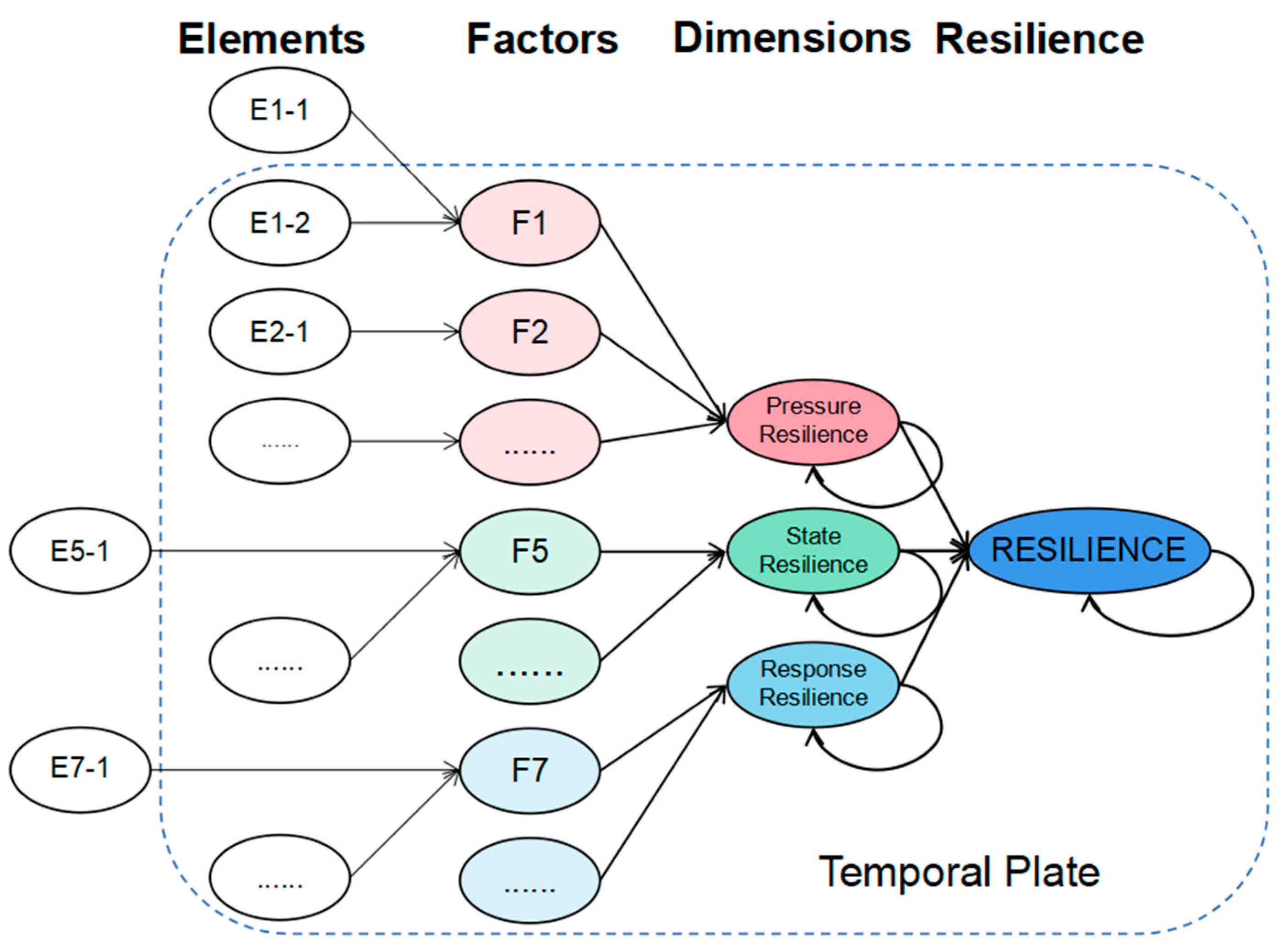
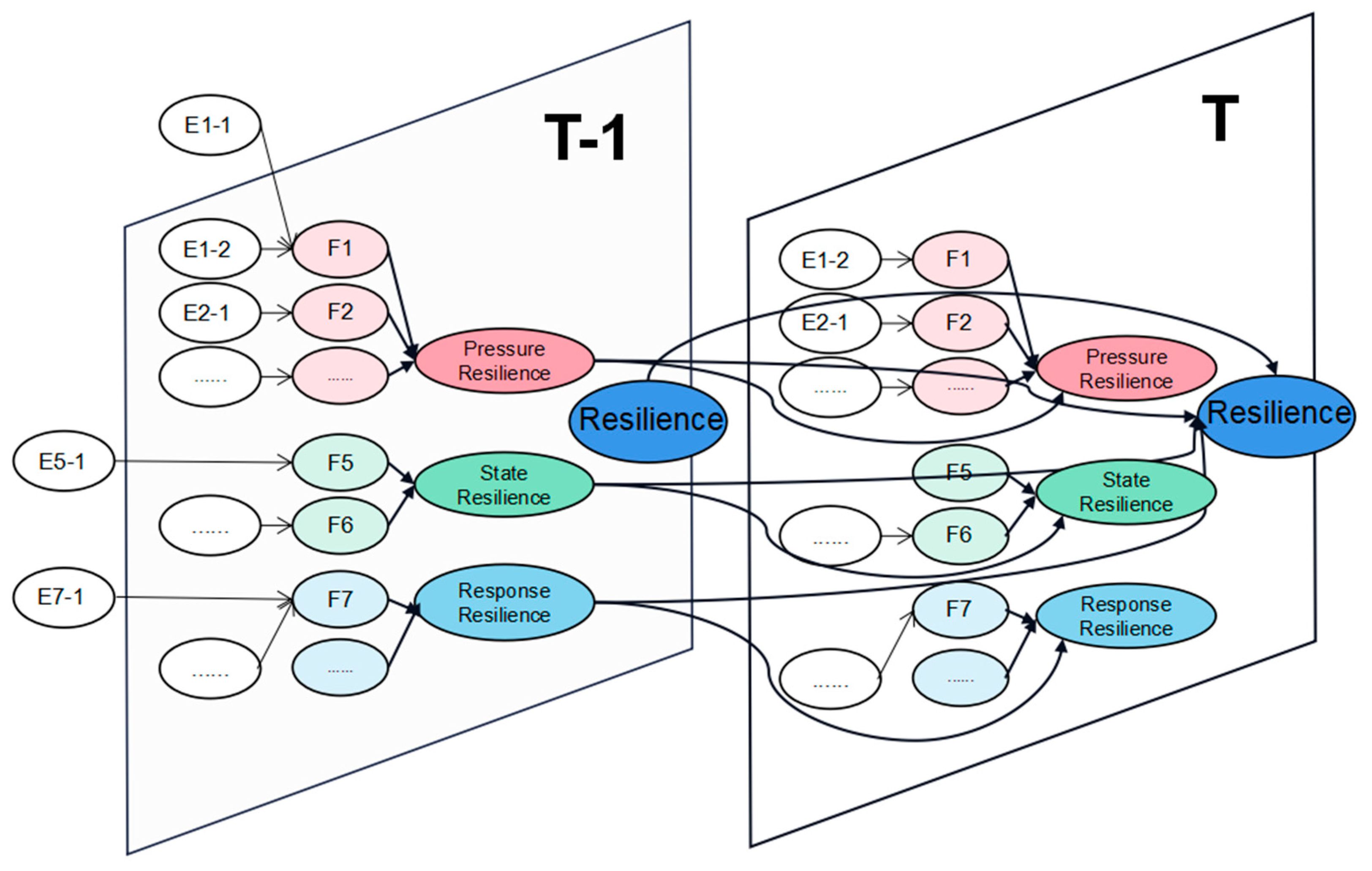
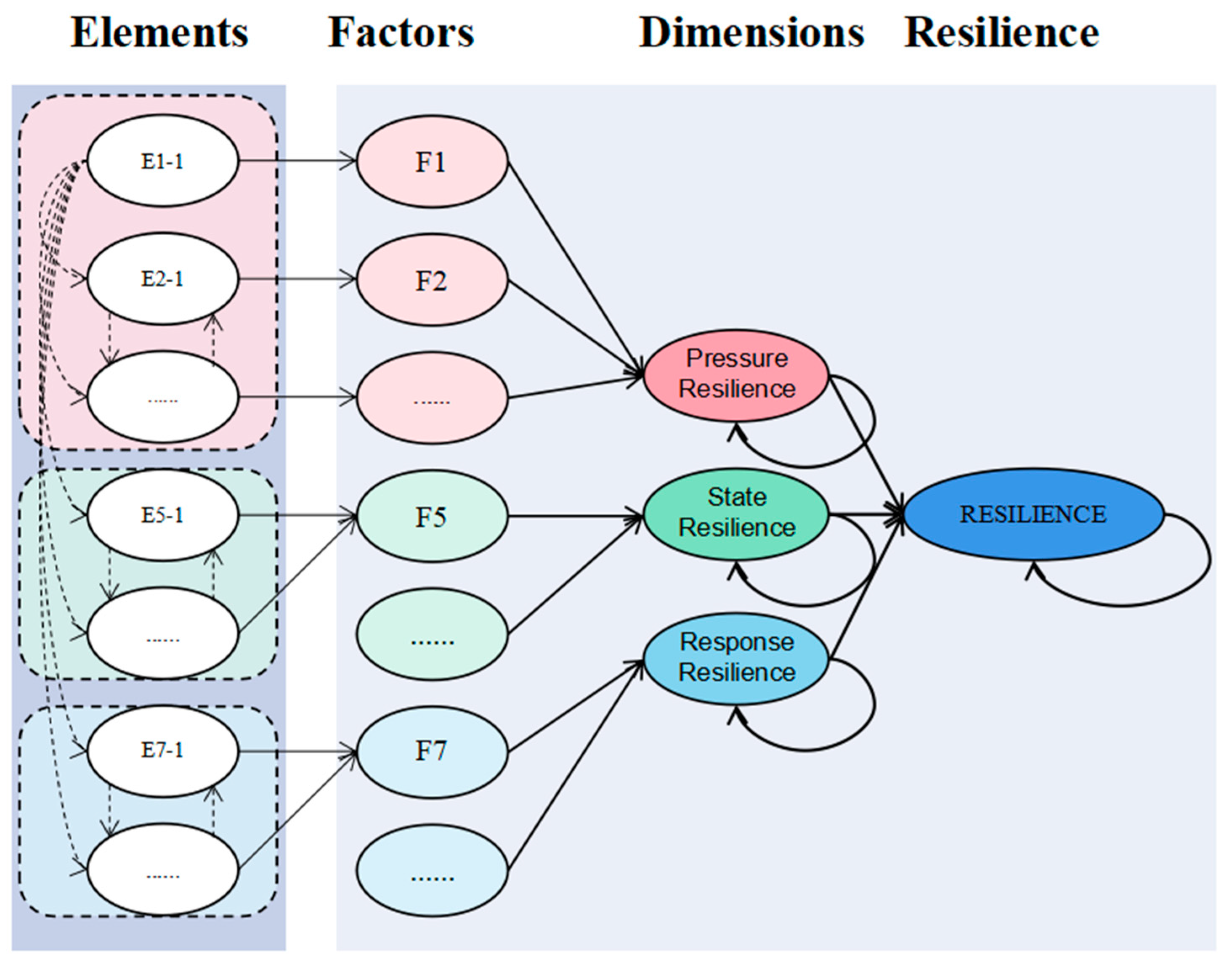
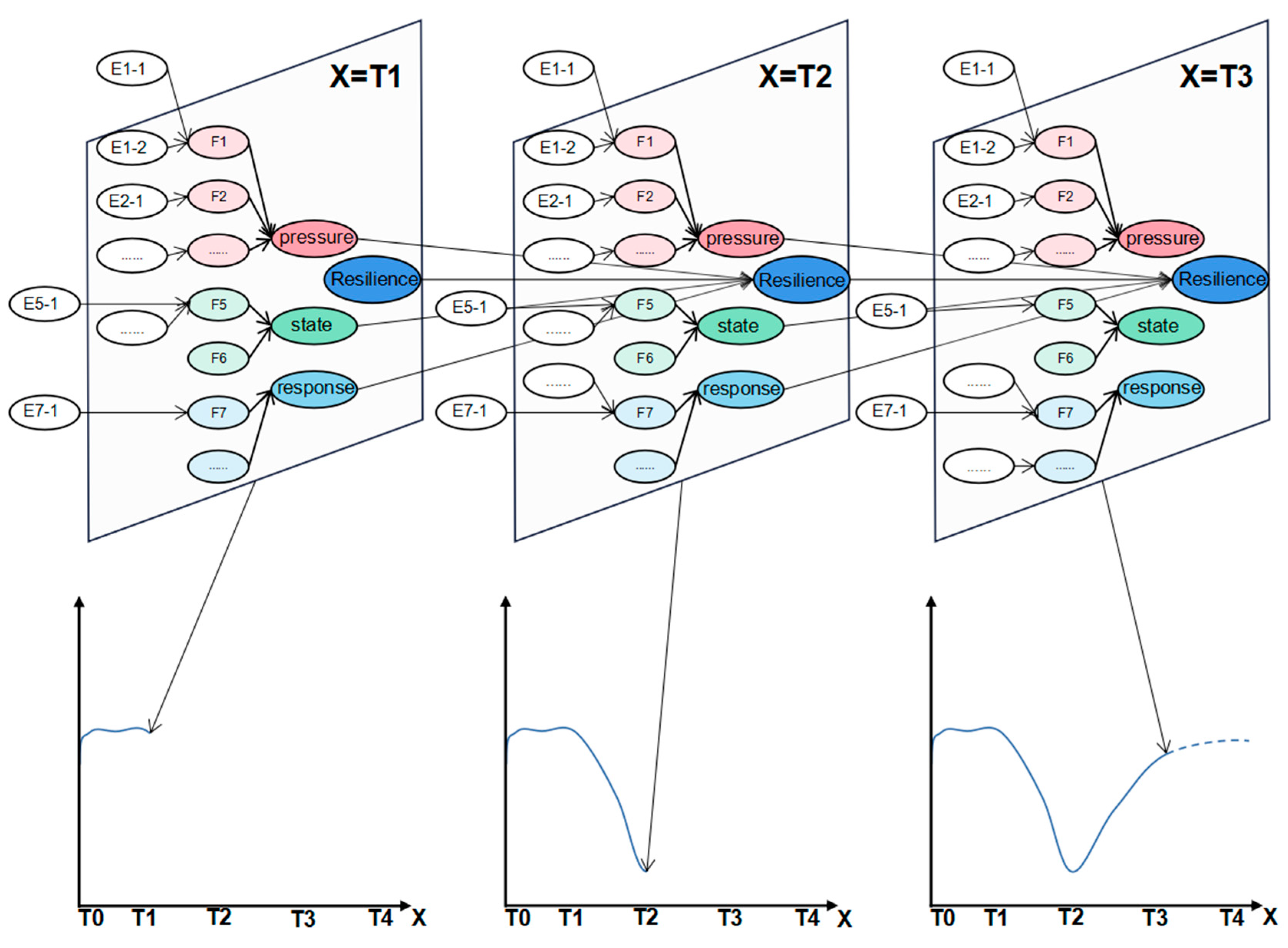
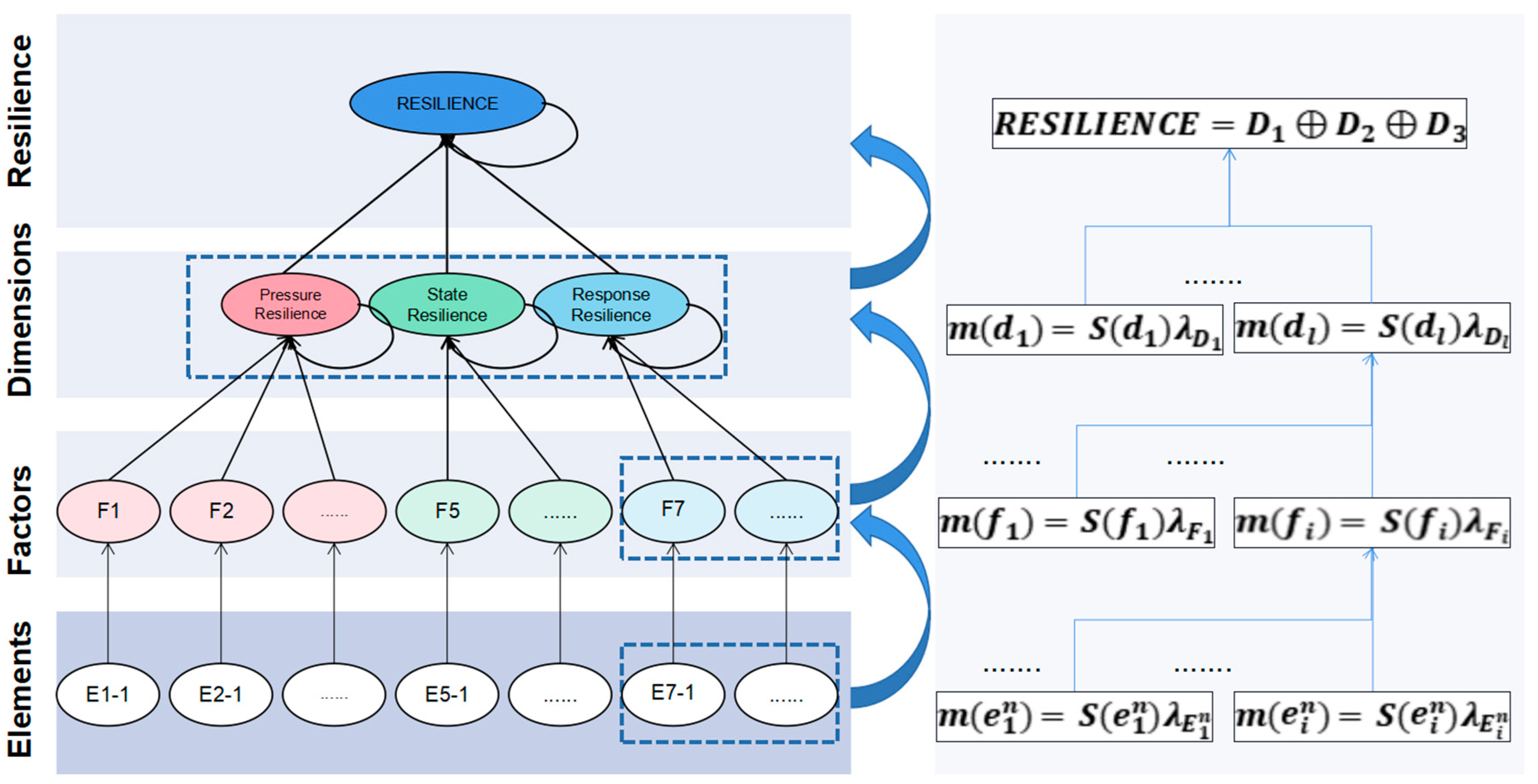
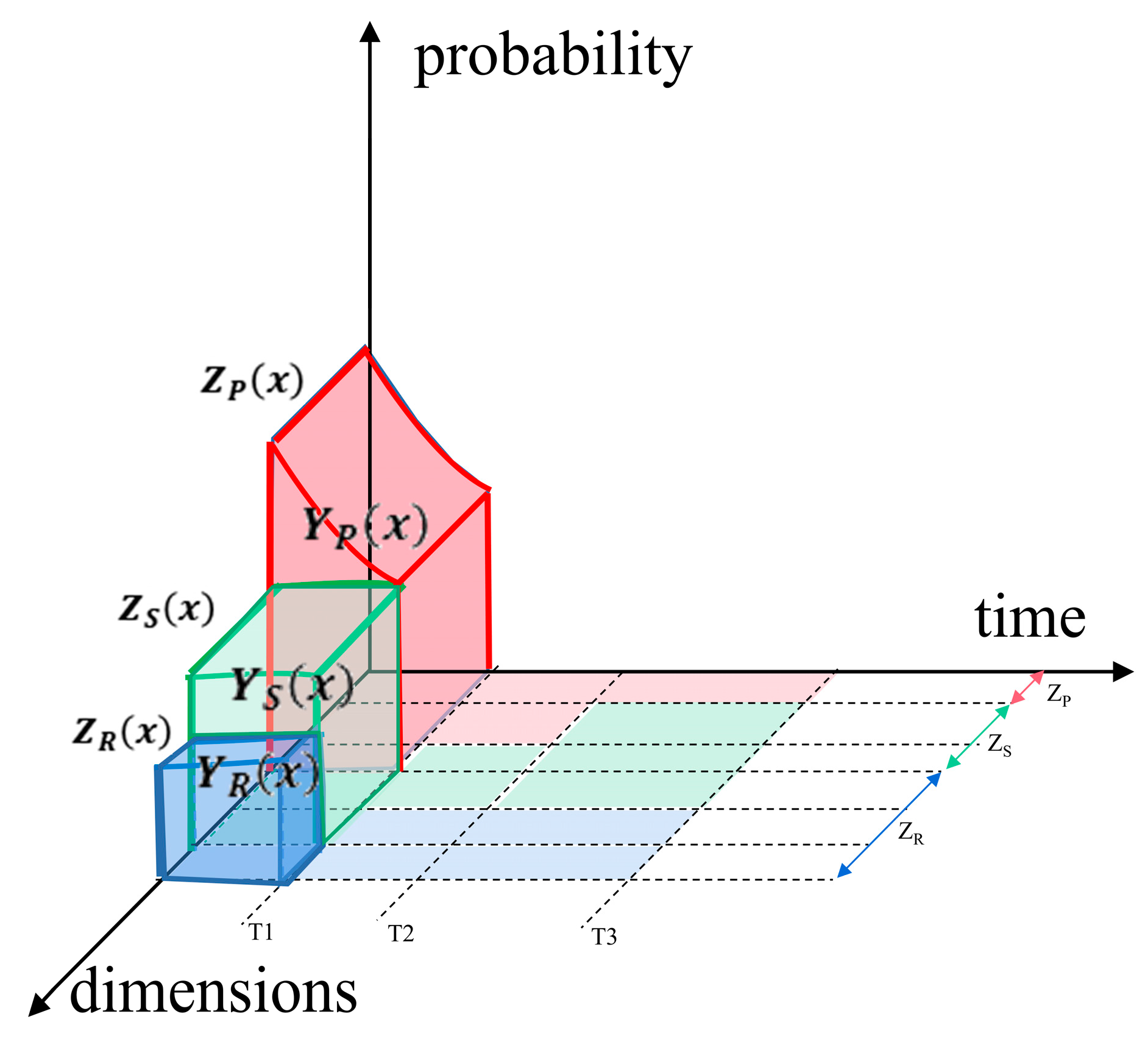

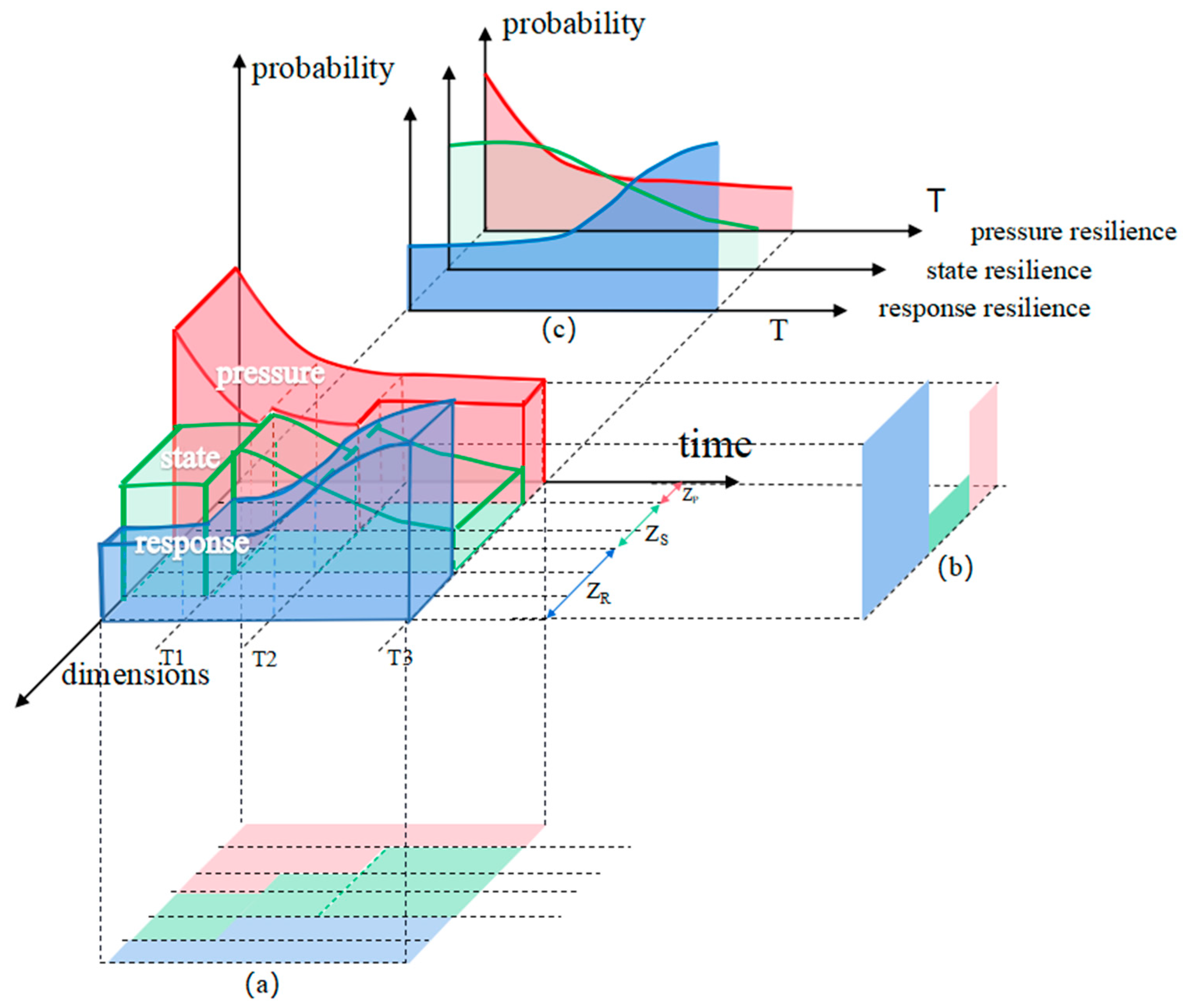




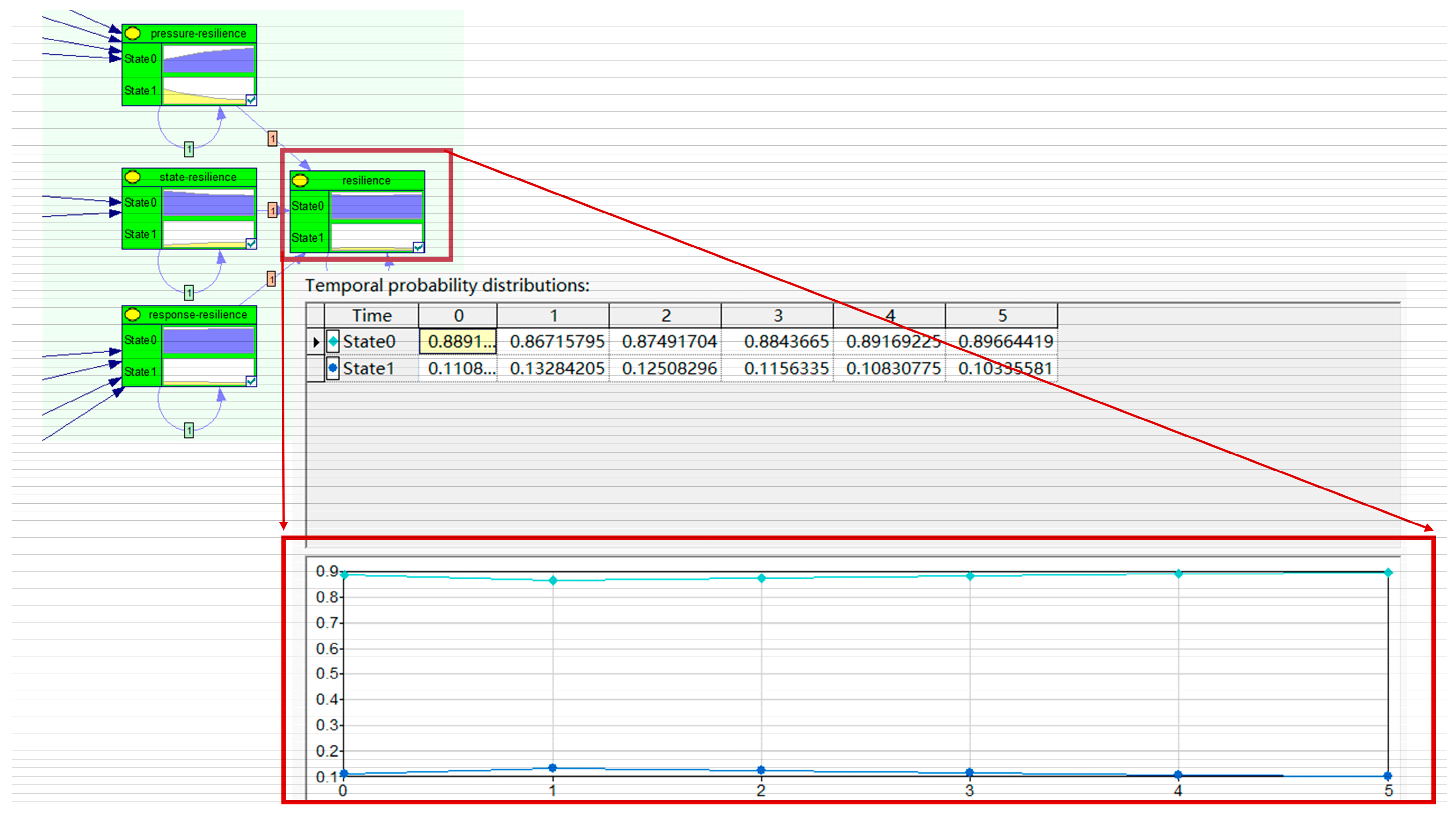
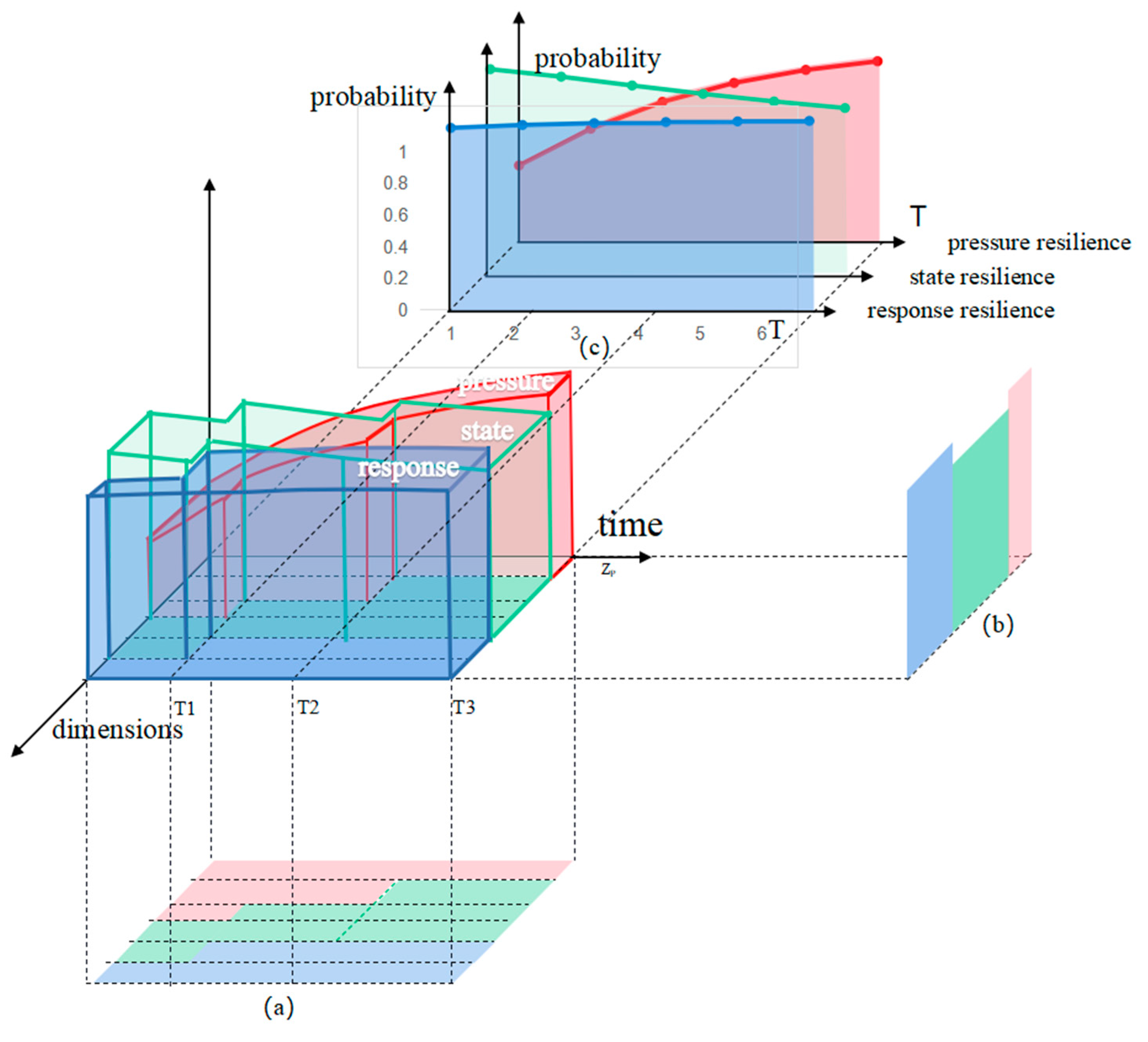


| Dimen -sions | Factors | Elements of the Defense Disturbance Phase | Elements of the Resistance Disturbance Phase | Elements of the Functional Recovery Phase |
|---|---|---|---|---|
| Pressure resilience | Exposure to pressure | Exposure to meteorology(E1-1) | ||
| Exposure to road types (E1-2) | ||||
| Exposure to traffic flows (E1-3) | ||||
| Diversity to pressure | Diversity of accident types (E2-1) | |||
| Diversity of vehicle types (E2-2) | ||||
| Uncertainty of pressure | Uncertainty of scattered objects (E3-1) | |||
| Uncertainty of fire (E3-2) | ||||
| Hazard of pressure | Hazardous to the facility (E4-1) | |||
| Hazardous to the vehicle involved (E4-2) | ||||
| Hazardous to casualties (E4-3) | ||||
| State resilience | State robustness | Robustness of road width (E5-1) | ||
| Robustness of road maintenance (E5-2) Robustness of pavement performance (E5-3) | ||||
| Robustness of lane access (E5-4) | ||||
| Robustness of facility functions (E5-5) | ||||
| State redundancy | Redundancy of design traffic capacity (E6-1) | |||
| Redundancy of road network connectivity (E6-2) | ||||
| Response resilience | Response awareness | Rapidity of response arrival (E7-1) | ||
| Rapidity of response | Implementability of response disposal (E8-1) | |||
| Rapidity of response disposal (E8-2) | ||||
| Resourcefulness of response | Availability of rescue resources (E9-1) | |||
| Availability of traction resources (E9-2) | ||||
| Availability of firefighting resources (E9-3) | ||||
| Responsive learnability | Emergency review capabilities (E10-1) |
| Dimensions | Elements | Data of Elements |
|---|---|---|
| Pressure resilience | Exposure to meteorology | Weather conditions |
| Exposure to road type | Road type of accident occurrence | |
| Exposure to traffic flow | Traffic flow | |
| Diversity of accident types | Accident type | |
| Diversity of vehicle types | Vehicle types | |
| Uncertainty of scattered objects | Scattered objects situation | |
| Uncertainty of fire | Fire situation | |
| Hazardous to facility losses | Facility losses | |
| Hazardous to the vehicle involved | Number of vehicles involved | |
| Hazardous to casualties | Casualty numbers | |
| State resilience | Robustness of road width | Road width |
| Robustness of road maintenance | Road maintenance situation | |
| Robustness of pavement performance | Pavement performance | |
| Robustness of lane access | Accessible lanes | |
| Robustness of facility functions | Facility functions | |
| Redundancy of road network connectivity | Road network connectivity | |
| Redundancy of design traffic capacity | Design traffic capacity | |
| Response resilience | Response awareness | Accident discovery time |
| Implementability of response disposal | Response arrival time | |
| Rapidity of response disposal | Disposal time | |
| Availability of rescue resources | Rescue resources | |
| Availability of traction resources | Traction resources | |
| Availability of firefighting resources | Firefighting resources | |
| Emergency review capabilities | Responsive learnability and review capacity |
| Data of Elements | Emergency Event 1 | Emergency Event 2 | Emergency Event 3 | Emergency Event 4 | ... |
|---|---|---|---|---|---|
| Weather conditions | 0 | 0 | 1 | 1 | ... |
| Road type of accident occurrence | 0 | 1 | 0 | 1 | ... |
| Traffic flow | 1 | 1 | 1 | 1 | ... |
| Accident type | 1 | 1 | 1 | 1 | ... |
| Vehicle types | 0 | 0 | 0 | 0 | ... |
| Scattered objects situation | 0 | 0 | 0 | 0 | ... |
| Fire situation | 0 | 0 | 0 | 0 | ... |
| Facility losses | 0 | 0 | 0 | 0 | ... |
| Number of vehicles involved | 1 | 0 | 1 | 1 | ... |
| Casualty numbers | 0 | 0 | 0 | 0 | ... |
| Road width | 0 | 1 | 0 | 0 | ... |
| Road maintenance situation | 0 | 0 | 0 | 0 | ... |
| Pavement performance | 0 | 0 | 1 | 0 | ... |
| Accessible lanes | 0 | 1 | 0 | 0 | ... |
| Facility functions | 0 | 1 | 0 | 0 | ... |
| Road network connectivity | 0 | 0 | 1 | 1 | ... |
| Design traffic capacity | 0 | 1 | 0 | 0 | ... |
| Accident discovery time | 0 | 0 | 0 | 0 | ... |
| Response arrival time | 0 | 1 | 0 | 0 | ... |
| Disposal time | 0 | 1 | 0 | 0 | ... |
| Rescue resources | 0 | 0 | 0 | 0 | ... |
| Traction resources | 0 | 1 | 0 | 0 | ... |
| Firefighting resources | 0 | 0 | 0 | 0 | ... |
| Responsive learnability and review capacity | 0 | 0 | 0 | 0 | ... |
| Method Step | Detailed Description of Each Step | |||
|---|---|---|---|---|
| Step 1 | Criteria number = 3 | Criterion 1 | Criterion 2 | Criterion 3 |
| Names of criteria | Pressure resilience | State resilience | Response resilience | |
| Select the best | Response resilience | |||
| Select the worst | State resilience | |||
| Step 2 | Names of criteria | Pressure resilience | State resilience | Response resilience |
| Best to others | 2 | 3 | 1 | |
| Step 3 | Others to the worst | 2 | 1 | 4 |
| Step 4 and Step 5 | Calculate node weights | 0.27 | 0.16 | 0.57 |
| Dimensions | Factors | Elements | Features of Time-Varying (Dynamic/Static) |
|---|---|---|---|
| Pressure resilience | Exposure to pressure | Exposure to meteorology | S |
| Exposure to road type | S | ||
| Exposure to traffic flow | D | ||
| Diversity of pressure | Diversity of accident types | S | |
| Diversity of vehicle types | S | ||
| Uncertainty of pressure | Uncertainty of scattered objects | S | |
| Uncertainty of fire | S | ||
| Hazardous to pressure | Hazardous to facility losses | S | |
| Hazardous to the vehicle involved | S | ||
| Hazardous to facility losses | S | ||
| State resilience | Robustness of states | Robustness of road width | S |
| Robustness of road maintenance | S | ||
| Robustness of pavement performance | S | ||
| Robustness of lane access | D | ||
| Robustness of facility functions | S | ||
| Redundancy of states | Redundancy of road network connectivity | S | |
| Redundancy of design traffic capacity | S | ||
| Response resilience | Response awareness | Response awareness | D |
| Rapidity of response | Implementability of response disposal | S | |
| Response resilience | Rapidity of response | Rapidity of response and disposal | D |
| Resourcefulness of response | Availability of rescue resources | S | |
| Availability of traction resources | S | ||
| Availability of firefighting resources | S | ||
| Responsive learnability | Emergency review capabilities | S |
| Dimensions | Weight of Dimensions | Factors | Weight of Factors | Elements | Weight of Elements |
|---|---|---|---|---|---|
| Pressure resilience | 0.34 | Exposure to pressure | 0.13 | Exposure to meteorology | 0.27 |
| Exposure to road type | 0.12 | ||||
| Exposure to traffic flow | 0.61 | ||||
| Diversity of pressure | 0.09 | Diversity of accident types | 0.7 | ||
| Diversity of vehicle types | 0.3 | ||||
| Uncertainty of pressure | 0.39 | Uncertainty of scattered objects | 0.6 | ||
| Uncertainty of fire | 0.4 | ||||
| Hazardous to pressure | 0.39 | Hazardous to facility losses | 0.16 | ||
| Hazardous to the vehicle involved | 0.42 | ||||
| Hazardous to casualties | 0.42 | ||||
| State resilience | 0.16 | Robustness of states | 0.8 | Robustness of road width | 0.07 |
| Robustness of road maintenance | 0.11 | ||||
| Robustness of pavement performance | 0.12 | ||||
| Robustness of lane access | 0.55 | ||||
| Robustness of facility functions | 0.17 | ||||
| Redundancy of states | 0.2 | Redundancy of road network connectivity | 0.7 | ||
| Redundancy of design traffic capacity | 0.3 | ||||
| Response resilience | 0.50 | Response awareness | 0.18 | Response awareness | 1 |
| Rapidity of response | 0.52 | Implementability of response disposal | 0.25 | ||
| Rapidity of response disposal | 0.75 | ||||
| Resourcefulness of response | 0.2 | Availability of rescue resources | 0.51 | ||
| Availability of traction resources | 0.18 | ||||
| Availability of firefighting resources | 0.31 | ||||
| Responsive learnability | 0.1 | Emergency review capabilities | 1 |
| Defense Disturbance Phase | Resistance Disturbance Phase | Functional Recovery Phase | |
|---|---|---|---|
| Pressure resilience | 0.51 | 0.33 | 0.15 |
| State resilience | 0.34 | 0.33 | 0.51 |
| Response resilience | 0.15 | 0.33 | 0.34 |
| Data of Elements | Exposure to Pressure | Diversity of Pressure | Uncertainty of Pressure | Hazardous to Pressure | Robustness of States | Redundancy of States | Response Awareness | Rapidity of Response | Resourcefulness of Response | Responsive Learnability |
|---|---|---|---|---|---|---|---|---|---|---|
| emergency event 1 | 1 | 1 | 0 | 0 | 0 | 0 | 0 | 0 | 0 | 0 |
| emergency event 2 | 1 | 1 | 0 | 0 | 1 | 0 | 0 | 1 | 0 | 0 |
| emergency event 3 | 1 | 1 | 0 | 0 | 0 | 1 | 0 | 0 | 0 | 0 |
| emergency event 4 | 1 | 1 | 0 | 0 | 0 | 1 | 0 | 0 | 0 | 0 |
| emergency event 5 | 1 | 1 | 0 | 0 | 1 | 0 | 0 | 0 | 0 | 0 |
| emergency event 6 | 1 | 1 | 0 | 0 | 0 | 0 | 0 | 0 | 0 | 0 |
| emergency event 7 | 1 | 1 | 0 | 0 | 0 | 1 | 0 | 0 | 0 | 1 |
| emergency event 8 | 1 | 0 | 1 | 0 | 0 | 0 | 0 | 0 | 0 | 0 |
| emergency event 9 | 1 | 1 | 0 | 0 | 0 | 1 | 1 | 0 | 0 | 0 |
| emergency event 10 | 0 | 1 | 0 | 0 | 0 | 1 | 0 | 0 | 0 | 0 |
| emergency event 11 | 1 | 1 | 0 | 0 | 0 | 1 | 0 | 0 | 0 | 0 |
| Data of Elements | Pressure Resilience | State Resilience | Response Resilience | RESILIENCE |
|---|---|---|---|---|
| emergency event 1 | 0 | 0 | 0 | 0 |
| emergency event 2 | 0 | 1 | 0 | 0 |
| emergency event 3 | 0 | 0 | 0 | 0 |
| emergency event 4 | 0 | 0 | 0 | 0 |
| emergency event 5 | 0 | 0 | 0 | 0 |
| emergency event 6 | 0 | 0 | 0 | 0 |
| emergency event 7 | 0 | 0 | 0 | 1 |
| emergency event 8 | 0 | 0 | 0 | 0 |
| emergency event 9 | 1 | 0 | 0 | 0 |
| emergency event 10 | 0 | 0 | 0 | 0 |
| emergency event 11 | 0 | 0 | 0 | 0 |
| Resilience | t = 1 | t = 2 | t = 3 | t = 4 | t = 5 |
|---|---|---|---|---|---|
| Overall accuracy | 0.970682 | 0.933369 | 0.953092 | 0.833156 | 0.918977 |
| The accuracy of State0 | 0.974576 | 0.965708 | 0.992072 | 0.986154 | 0.886105 |
| The accuracy of State1 | 0.966738 | 0.903292 | 0.918429 | 0.752039 | 0.929019 |
Disclaimer/Publisher’s Note: The statements, opinions and data contained in all publications are solely those of the individual author(s) and contributor(s) and not of MDPI and/or the editor(s). MDPI and/or the editor(s) disclaim responsibility for any injury to people or property resulting from any ideas, methods, instructions or products referred to in the content. |
© 2023 by the authors. Licensee MDPI, Basel, Switzerland. This article is an open access article distributed under the terms and conditions of the Creative Commons Attribution (CC BY) license (https://creativecommons.org/licenses/by/4.0/).
Share and Cite
Yu, G.; Lin, D.; Xie, J.; Wang, Y.K. A Novel Approach for Modeling and Evaluating Road Operational Resilience Based on Pressure-State-Response Theory and Dynamic Bayesian Networks. Appl. Sci. 2023, 13, 7481. https://doi.org/10.3390/app13137481
Yu G, Lin D, Xie J, Wang YK. A Novel Approach for Modeling and Evaluating Road Operational Resilience Based on Pressure-State-Response Theory and Dynamic Bayesian Networks. Applied Sciences. 2023; 13(13):7481. https://doi.org/10.3390/app13137481
Chicago/Turabian StyleYu, Gang, Dinghao Lin, Jiayi Xie, and Ye. Ken Wang. 2023. "A Novel Approach for Modeling and Evaluating Road Operational Resilience Based on Pressure-State-Response Theory and Dynamic Bayesian Networks" Applied Sciences 13, no. 13: 7481. https://doi.org/10.3390/app13137481







